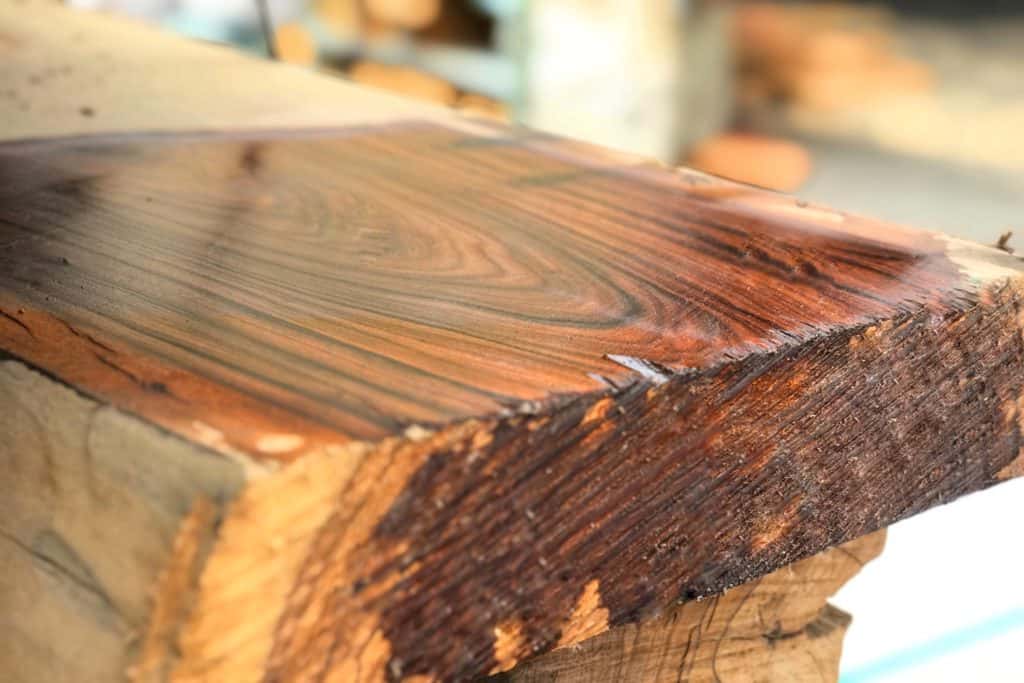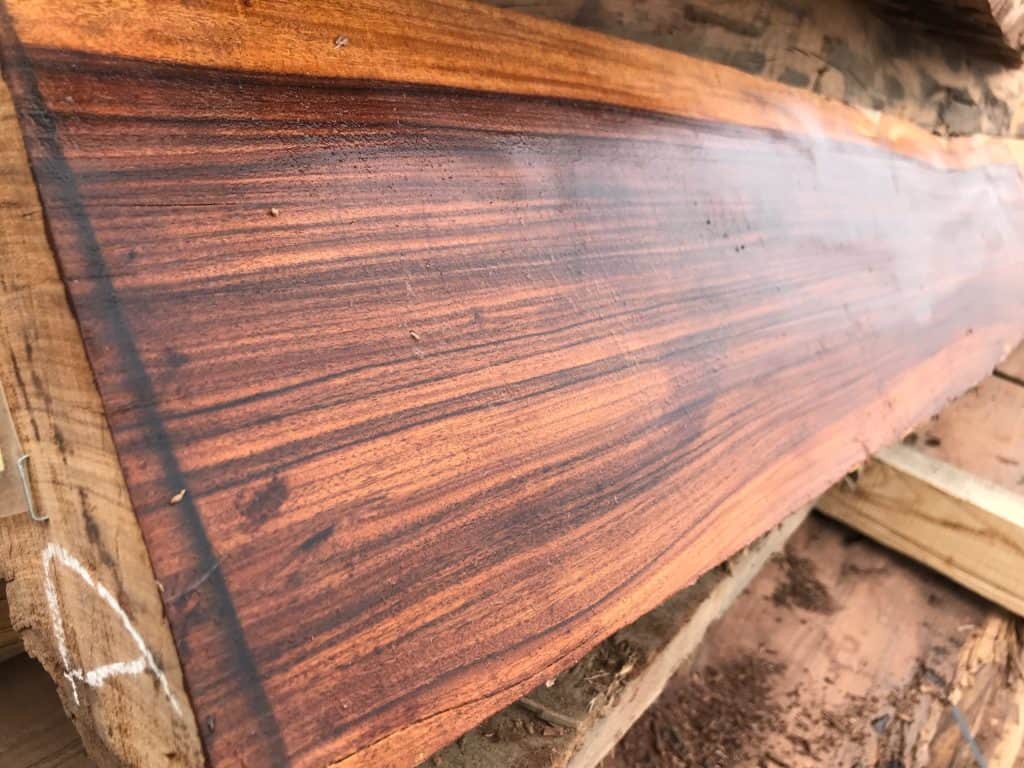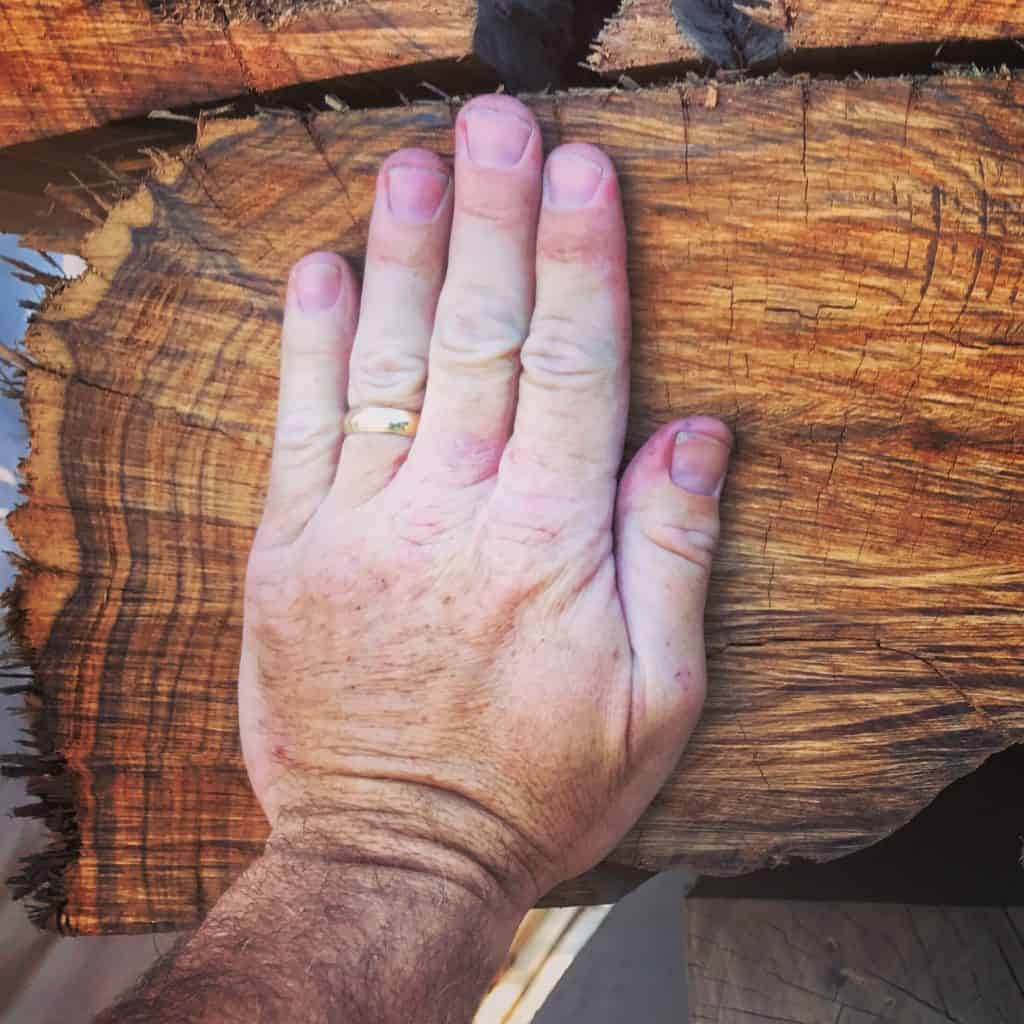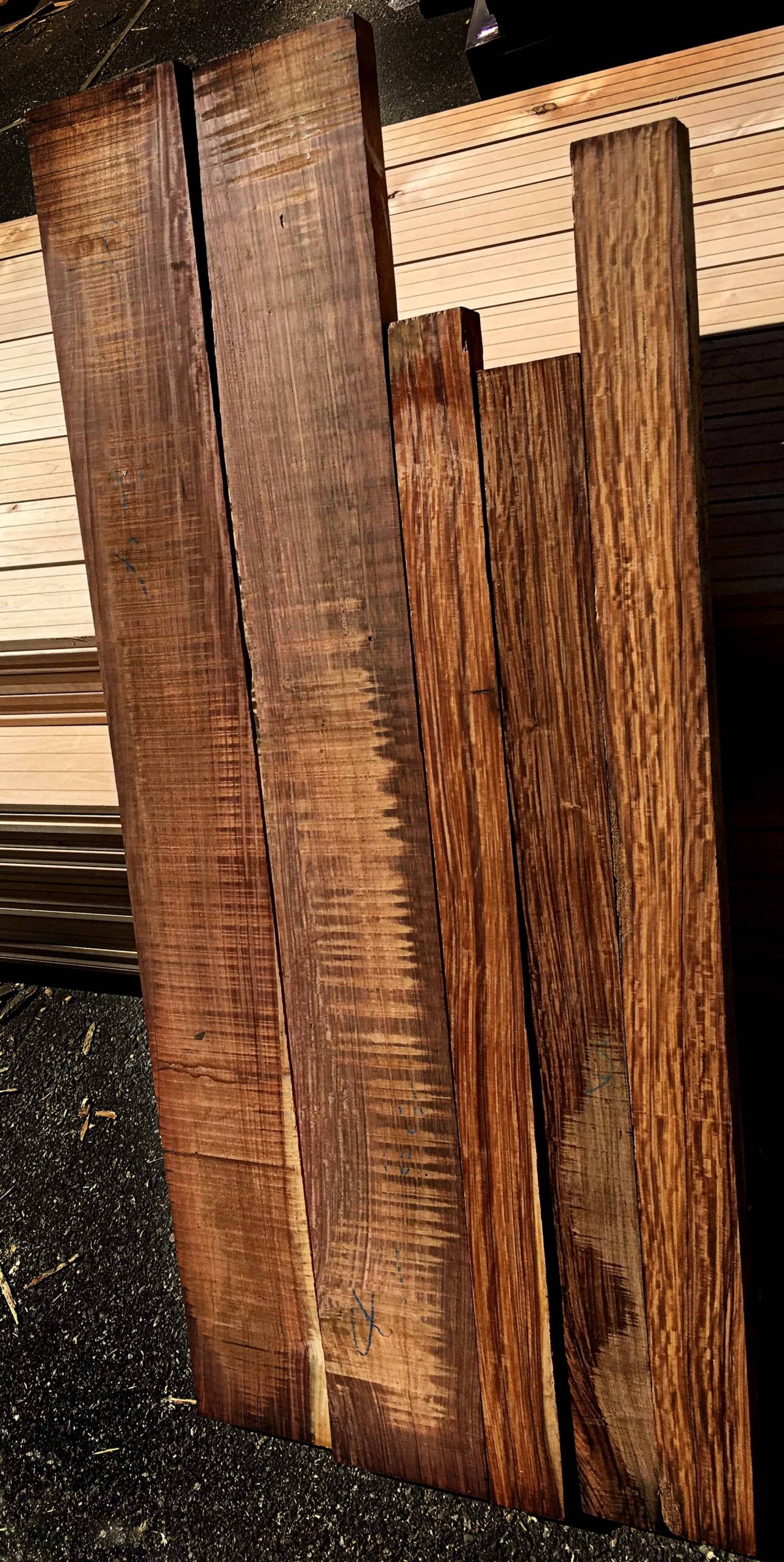Pau Ferro Wood vs Rosewood
Technical Information
- Scientific name: Machaerium scleroxylon
- Alternative Names: Morado, Bolivian Rosewood, Santos Rosewood
- Region of Origin: South America
- Average Dried Weight: 55 LB/cubic foot
- Janka Hardness Rating: 1960
- Specific Gravity: .87
- IUCN Red List: no
- CITES wood: no

Pau Ferro Wood Characteristics
Libidibia ferreaPlantsLibidibia ferrea, formerly Caesalpinia ferrea, and commonly known as Pau Ferro, Brazilian ironwood, Morado, or leopard tree, is a tree found in Brazil and Bolivia.
Sometimes called Morado wood, Bolivan Rosewood or Santos Rosewood, Pau Ferro is a South American exotic wood. Additionally, it has a somewhat similar appearance to Honduras Rosewood. However, it is not a related specie.
Also, prized for its beauty and density, Bolivian Rosewood is a popular musical instrument tonewood. Additionally, furniture and millwork manufacturers use 5/4 Morado for its rich dark colors. The colors variation for complexity. Also, 5/4 Pau Ferro wood takes on a high luster once finished.
Accordingly, many woodworkers assume that 5/4 Bolivian Rosewood is a true rosewood. However, unlike Brazilian Kingwood, it is not a Dalbergia rosewood. Instead, its common name is based on appearance, not biological makeup.
Bolivian Rosewood Applications
Common uses of Pau Ferro mirror those of Indian Rosewood. Accordingly, Morado uses include:
- Guitar Necks
- Fingerboards
- Musical instrument tonewood
- Exotic gun grips
- Wood knife grips
- Furniture
- Flooring
- Guitar backs and sides
- Wood turning
- Pen turning
- Box making
- Architectural Millwork
Map of Bolivian Rosewood Production Region

Pau Ferro Wood as an Indian Rosewood Alternative
With East Indian Rosewood on CITES, Pau Ferro is the logical Rosewood alternative. For example, musical instrument manufacturers such as Fender increasingly use Morado in their production.
To clarify, Fender cites the hardness, oil content, tone and color of Pau Ferro as reasons for switching from Indian Rosewood to Morado fretboards. For reference, their Standard Series, Deluxe Series and Classic Series instruments now feature Morado fretboards.
Compare Morado to East Indian Rosewood
Side by Side Picture of Pau Ferro and East Indian Rosewood
Visually, both woods are very similar. However, East Indian Rosewood is slightly darker in color. Also, Pau Ferro has a slightly reddish/brown color tone. Additionally, the contrast between heartwood and sapwood in Morado is more pronounced than in Indian Rosewood.
Also, color consistency in both Rosewood and Pau Ferro depends significantly on the region of harvest. As with most woods, fast growth and heavy soil mineral content results in variegated lumber colors.
Pau Ferro vs Rosewood
CITES Wood?
East Indian Rosewood is a CITES wood.
However, Morado is not a CITES wood.
IUCN Red List:
East Indian Rosewood is classified as vulnerable.
Significantly, Morado is classified as of least concern.
Wood Genus:
East Indian Rosewood is Dalbergia.
However, Morado is Machaerium
Specific Gravity (KD):
East Indian Rosewood specific gravity is .85.
Similarly, Morado specific gravity is .87.
Average tree length:
East Indian Rosewood average tree length is 90′.
Similarly, Morado average tree length is 80′.
Tree diameter average:
East Indian Rosewood average tree diameter is 36″.
Significantly, Morado average tree diameter is 48″.
Average board width:
East Indian Rosewood average board width is 5″.
In contrast Morado average board width is 6″.
Board length average:
East Indian Rosewood average board length is 4.5′.
Alternatively, Morado average board length is 6.0′.
Grades Available:
East Indian Rosewood grade is select/better.
However, Morado grade is select/better, #1 Common, #2 Common.
Janka Rating:
East Indian Rosewood Janka rating is 2440.
Significantly, Morado Janka rating is 1960.
Weight/Board Foot:
East Indian Rosewood average kiln dried weight per board foot is 4.5LB.
Similarly, Morado average kiln dried weight per board foot is 4.4LB.
Bolivian Rosewood Sustainability

What to Know Before Working With Santos Rosewood
Woodworkers using Morado should know these four Morado characteristics.
Oil Content
Like Indian Rosewood, Santos Rosewood contains oils. Accordingly, these oils contribute to the high luster appearance. They also provide durability and moisture resistance. However, those same oils complicate finishing and gluing procedures. Additionally, read how to finish Pau Ferro, here.
Silica Content
Significantly, Pau Ferro sometimes contains low to mid levels of silica which blunts tools. Interestingly, Silica is much more common in imported tropical woods than domestic species.
In my experience milling Bolivian Rosewood, its silica levels are not as high as found in woods like teak or okoume. However, silica levels seem higher than most Genuine Mahogany. For reference, African Mahogany or Limba seem to dull knife blades at about the same rate as Pau Ferro. Again, this is just my personal experience.
Sawdust Allergies
According to the Department of Dematology at Gentofte Hospital in Denmark, Morado sawdust contains allergens. However, only a small percentage of woodworkers are affected. Also, symptoms are largely limited to skin irritation. Fortunately, most affected woodworkers quickly develop an immunity.
For reference, allergies are similar to those occurring in the true Dalbergia Rosewoods.
Kiln Drying Difficulty
Due to its density, Santos Rosewood is difficult to kiln dry well. Thus, it is prone to checks and splits when drying occurs too rapidly or unevenly. As a result, drying defects are common in this imported wood. Typically, 5/4, 6/4, 8/4. 10/4 12/4 and 16/4 Pau Ferro are more prone to kiln drying difficulties than 4/4 Pau Ferro. Essentially, drying defects increase in relation to wood thickness.
Best Practices When Finishing Pau Ferro
Significantly, the oils present in Pau Ferro react poorly with many finishes. As a result, the finish often fails to cures, leaving the wood surface sticky and undesirable. However, Morado can be finished well, just like you see in commercial products.
Follow these best practices when finishing Bolivian Rosewood:
- First, avoid using a finish that dries via oxidation. Significantly, shellac and nitro-cellulose lacquer dry on Pau Ferro because they do not rely on oxidation to cure. The aptly name anti-oxidants in Pau Ferro prevent oxidation from occurring. Thus, the finish does not take.
- Use a seal coat first. Accordingly, applying a coat of dewaxed shellac will help contain the natural Pau Ferro oils. As a result, subsequent coats of oxidation-based finishes will cure more easily. This critical Woodshop News article on shellac confirms. Although the article debunks shellac’s hype as a finish, it also concedes that one of it’s best applications is as a sealer of exotic woods.
- Oil-based finishes on Bolivian Rosewood are problematic, even with a seal coat. Therefore, any finish that requires wood penetration will struggle on top of a sealer coat.
References for finishing information:
- Finishing Oily Woods. (2011, March 3). Retrieved from https://www.thewoodwhisperer.com/articles/finishing-oily-woods/
- Muzo, J. (2017, March 19). Understanding the Different Kinds of Wood Finishes. Retrieved from http://blog.lafurniturestore.com/understanding-different-kinds-wood-finishes/
- Meier, E. (2018, January 18) Finishing Exotic and Tropical Woods. Retrieved from https://www.wood-database.com/wood-articles/finishing-exotic-tropical-hardwoods/

Pau Ferro Fretboard Care
On a guitar, the fretboard receives most of the finger grime. Accordingly, if you clean only one part of your guitar it should be the fretboard.
To reiterate, Pau Ferro has natural oils. Thus, it may disguise some of the oils left from your fingers.
Cleaning Your Pau Ferro Fretboard
To clean your fretboard properly, follow these three steps:
- Take off your guitar strings. Oddly, guitarists on a perpetual quest for better tone are often guilty of leaving their strings on too long. Pro tip: Replace your strings and get a proper set-up before seeking out a replacement guitar with better mojo.
- Remove built up oils and grease with fine steel wool. Light pressure applied with fine steel wool will clean your pau ferro fretboard without damaging your fingerboard surface.
- Apply a light coat of lemon oil. This will add moisture back into to your fretboard.
Reference:
- How to Clean a Guitar – the Ultimate Guide. (2018, March 20). Retrieved from https://blog.andertons.co.uk/learn/how-to-clean-a-guitar
Darkening Pau Ferro: One Secret
When comparing Pau Ferro vs. Rosewood, the color shade is sometimes point of contention. Typically, Morado is a little lighter in color than East Indian Rosewood, generally speaking.
However, there is a quick hack that can quickly and easily darken your Pau Ferro fingerboard. Additionally, it also works for Ebony fretboards.
Use India Ink to Darken Your Fingerboard
India ink is about as dark as Trent Resnor delivering a child’s eulogy. Therefore, don’t be careless with it. India ink is not watercolor.
- First, wear gloves.
- Next, remove strings and protect the hardware and anything you don’t want to dye.
- Then, clean and sand your fretboard with fine steel wool or super high-grit sandpaper.
- Next, wipe on the India Ink with a cloth.
- Discard the cloth.
- Let the ink dry for at least 24 hours.
- Use a wet cloth to wipe off any excess ink.
- Wait 24 hours.
- Finally, lightly bush with superfine steel wool, again.
Reference:
Black Fingerboard Stain. Retrieved from https://www.stewmac.com/Materials_and_Supplies/Finishing_Supplies/Colors_and_Tints_and_Stains/Black_Fingerboard_Stain.html
Bolivian Rosewood: 2019-2020 Availability
In terms of shipments into North America, specifically, the United States, Pau Ferro availability is tight in 2019. In my opinion, Morado supply will remain sporadic going into 2020.
Most of the available Pau Ferro is limited to 4/4 thickness. By limiting production to 4/4, sawmills sidestep potential kiln drying issues. Additionally, their inventory turns faster due to quicker kiln drying times. Finally, most consumer demand is for 4/4 Pau Ferro.
However, this leaves buyers of the following thicknesses with few options:
- 5/4
- 6/4
- 8/4
- 10/4
- 12/4
- 16/4
Fortunately, we have thick Bolivian Rosewood lumber available. Even though demand for thick Morado is sporadic, we like to have it available. Oddly, nothing makes me happier than supplying a difficult to find wood. I’m weird like that!
Therefore, please contact me if you can’t the Pau Ferro you need.




Pingback: 8/4 Kingwood: Rare Exotic Hardwood Lumber - Commercial Forest Products
Pingback: 8/4 Kingwood: Rare Exotic Lumber - Commercial Forest Products
Pingback: Ebony Lumber: Macassar Ebony Wood - Commercial Forest Products
Pingback: Chatoyancy - What is Chatoyance in Figured Wood? -
Pingback: GRANADILLO Rosewood Lumber - Commercial Forest Products 2020
Pingback: CALCULATING BOARD FEET: All You Need To Know 2022 - * 2021 UPDATE